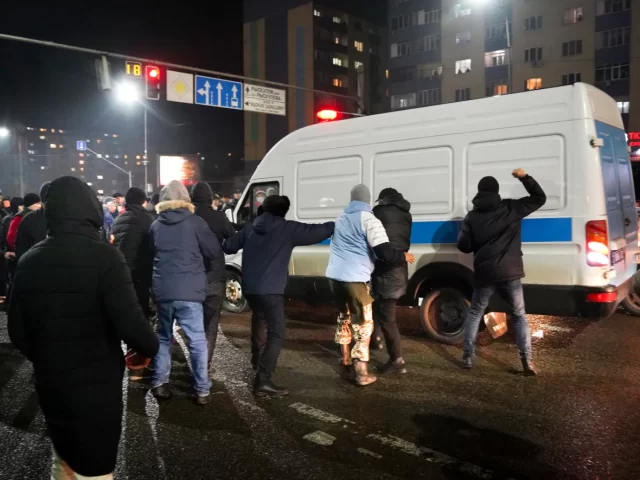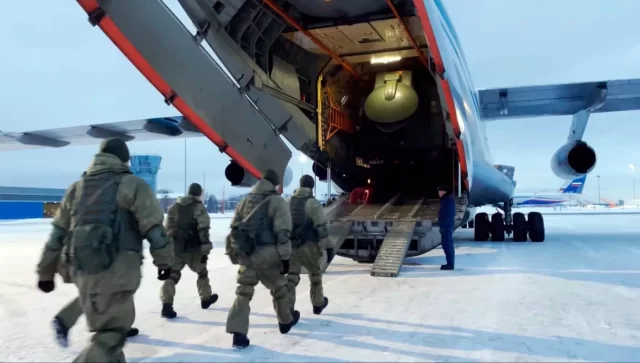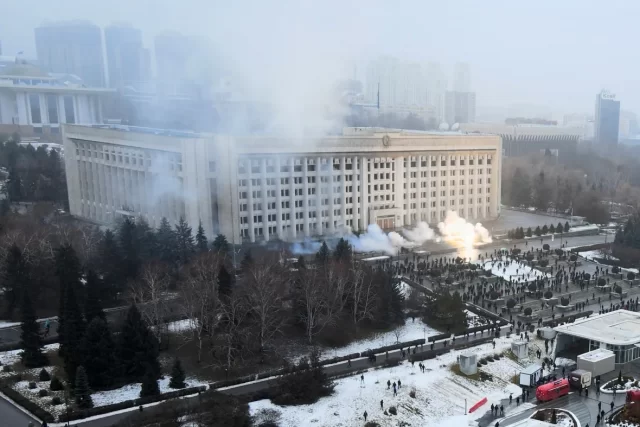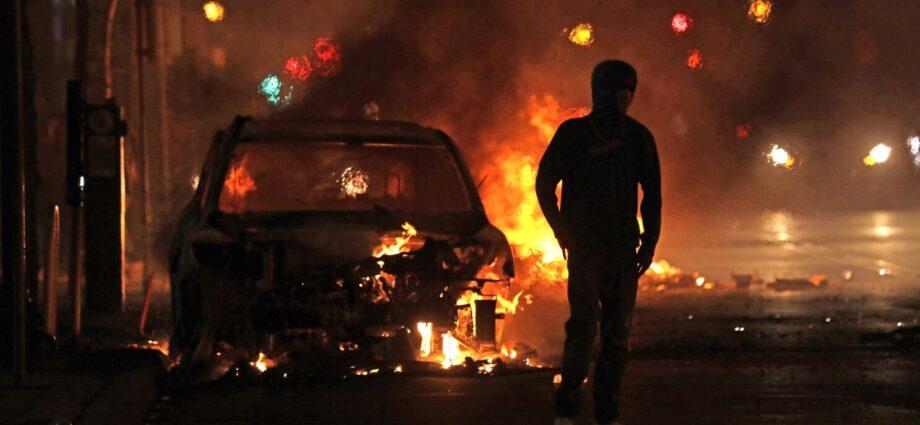Security forces killed dozens of protesters and 12 police died during extraordinarily violent demonstrations in Kazakhstan that saw government buildings stormed and set ablaze, authorities said Thursday. Two police officers were found beheaded in escalating unrest that poses a growing challenge to authoritarian rule in the Central Asian nation.
Despite the severe response by authorities, protesters took the streets again in the country’s largest city, Almaty, a day after breaking into the presidential residence and the mayor’s office there. Police were also out in force, including in the capital of Nur-Sultan, which was reportedly quiet, and Russian troops were on their way.

Protesters try to block a police van during a protest in the centre of Almaty on Tuesday. (Vladimir Tretyakov/The Associated Press)
Video from the Russian news agency Tass showed police firing intensely on a street near Republic Square, where demonstrators had gathered, though they could not be seen in the footage. Late Thursday, Tass said protesters had been swept from the square but that sporadic gunfire in the area continued.Video from the Russian news agency Tass showed police firing intensely on a street near Republic Square, where demonstrators had gathered, though they could not be seen in the footage. Late Thursday, Tass said protesters had been swept from the square but that sporadic gunfire in the area continued.
Earlier, Russia’s Sputnik news service reported that shots were fired as police surrounded one group of about 200 protesters in the city.
So far, 2,298 people have been detained, the Interior Ministry said.
In the unrest on Wednesday, “dozens of attackers were liquidated,” police spokeswoman Saltanat Azirbek told state news channel Khabar-24, using a term common to describe the killing of people thought to be extremists by law enforcement.
Twelve police officers were killed in the unrest and 353 injured, according to city officials cited by the channel.

Russian peacekeepers board a military plane at an airfield outside Moscow to fly to Kazakhstan on Thursday. (Russian Defense Ministry Press Service/The Associated Press)
Tens of thousands of people, some reportedly carrying clubs and shields, have taken to the streets in recent days in the worst protests the country has seen since gaining independence from the Soviet Union three decades ago.
Although the demonstrations began over a near-doubling of prices for a type of vehicle fuel, their size and rapid spread suggest wider discontent in a country that has been under the rule of the same party since independence.
The government on Thursday announced a 180-day price cap on vehicle fuel and a moratorium on raising utility rates — an attempt to address the economic issues that catalyzed the protests. It was unclear what, if any, effect the moves would have.
The president has vacillated between attempts at mollifying the protesters, including accepting the resignation of his government, and promising harsh measures to quell the unrest, which he blamed on “terrorist bands.”
Worries that a broader crackdown could be on the horizon grew after Tokayev called on a Russia-led military alliance, the Collective Security Treaty Organization, for help. Severe interruptions to internet and cell phone service also raised concern and made it difficult — sometimes impossible — for news of what was happening inside Kazakhstan to get out.
In other apparent attempts to seal the country off, the airports in Almaty and one other city have been shut.
The CSTO said early Thursday that it would send peacekeeper troops to Kazakhstan at Tokayev’s request.

Smoke rises from the city hall building during a protest in Almaty on Wednesday. News outlets in Kazakhstan reported that demonstrators protesting rising fuel prices broke into the mayor’s office and flames were seen coming from inside. (Yan Blagov/The Associated Press)
The operation is the first military action by the alliance — an indication that Kazakhstan’s neighbours, particularly Russia, are concerned that the unrest could spread.
Russia and Kazakhstan share close relations and a 7600-kilometer (4700-mile) border, much of it along open steppes. Russia’s manned space-launch facility, the Baikonur Cosmodrome, is in Kazakhstan.
The size and duties of the force have not been specified. Russia has already begun sending forces, according to the CSTO, which also includes Kazakhstan, Armenia, Belarus, Kyrgyzstan and Tajikistan. But Kyrgyzstan’s presidential spokesman, Erbol Sutanbaev, said his country’s contingent must be approved by parliament and said that the troops would not take actions involving demonstrators.
It was not immediately clear if any of the Russian forces had arrived in Kazakhstan.
The unrest was also causing worry elsewhere. U.S. Secretary of State Antony Blinken spoke by telephone with his Kazakh counterpart, Mukhtar Tileuberdi, and “reiterated the United States’ full support for Kazakhstan’s constitutional institutions and media freedom and advocated for a peaceful, rights-respecting resolution to the crisis,” said State Department spokesman Ned Price.
France condemned the violence and called for “de-escalation and responsibility” from all parties involved, including the CSTO.
Resources:
https://www.cp24.com/world/dozens-of-protesters-12-police-dead-in-kazakhstan-protests-1.5729647
https://www.cbc.ca/news/world/kazakhstan-troops-clash-shots-1.6305727

